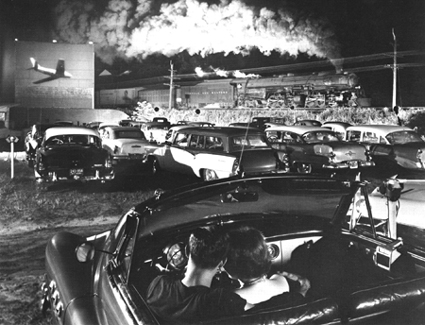|
Reviews of Recent Independent, Foreign, & Documentary Films in Theaters and DVD/Home Video
Directed & Produced by: Paul Yule. Edited by: John Street. Music by: Donald Fraser. Released by: First Run/Icarus Films. Country of Origin: USA/UK. 79 min. Not Rated.
The Photographer, His Wife, Her Lover is a poignant and revelatory
exploration of the art scandal which pushed O. Winston Link’s work into a new realm of fame. With constant cuts to rather creepy
footage of the then-newly married couple from a documentary he made 15 years earlier, director Paul Yule details how O. Winston Link was robbed by his much younger wife and business manager, Conchita Mendoza.
In 1983, Link’s beautiful black-and-white nighttime photographs of the last steam locomotives in 1950’s America became largely recognized for their artistic value by art dealers worldwide. That same year, Link married Conchita Mendoza, a 48-year-old “Spanish bombshell,” who was looking to buy Link’s apartment for her sister. He was 73.
According to prosecutors, Mendoza, who admits to sharing a less than passionate romance with Link, proceeded to brainwash
her husband so that he did not seem fully aware she was keeping him captive in their downstairs basement, where he could do nothing but produce more and more prints of his photographs (over a million dollars worth, to be precise), which she allegedly stole and sold for her own benefit.
The documentary’s most bizarre aspect is that it reveals Mendoza as a rather sympathetic character – we see her
now older with tears in her eyes, in an orange prison suit, and wonder, did she really do it? She claims not,
although her evidence is not altogether convincing. (At one point, she claims Winston, at age 83, beat her up. Winston’s lawyer,
however, holds up a piece of photographic evidence – Mendoza’s blue and swollen face – disclosing that her plastic surgeon
confirmed to him her wounds were the result of recent eye surgery). Mendoza is not reliable, and perhaps neither are the lawyers who prosecuted her. When Yule asks one if he had the original document showing Winston had kept a tally
of his prints (which would prove Mendoza had stolen
over 1400 of them), the lawyer said he didn't, and he didn't know
where it was. Everything had been "photocopied."
The viewer’s struggle, the implicit tension that moves the footage along, is that we never really know who to believe, who to trust, or even who to empathize with. On the surface, it seems we should side with the elderly man who was allegedly cheated, who, according to the then-Westchester County District Attorney Jeanine Pirro, was “a very sweet old man.” Then an interview with Link’s longtime friend and confidante reveals Link was racist, anti-Semitic, and a moody womanizer.
This elusive, untraditional, seemingly unbiased documentary of this photographer, his wife, and her lover (Edward Hayes, who apparently took part in the conspiracy against Link) is definitely worth a view – if not for the luridness of the matter, then for the way Yule (a big fan of Link’s work) managed to treat the account as a commentary on the elusive nature of truth, and the impossibility and futility of categorizing people as either black or white. The most telling quote in the film is a smug Jeanine Pirro telling us matter-of-factly at the end, “The good news is the good guys won and the bad lady lost.” The irony is that we never really know who the good guys were, and whether the bad lady really was as bad as the good guys said she was.
Parisa Vaziri
|

